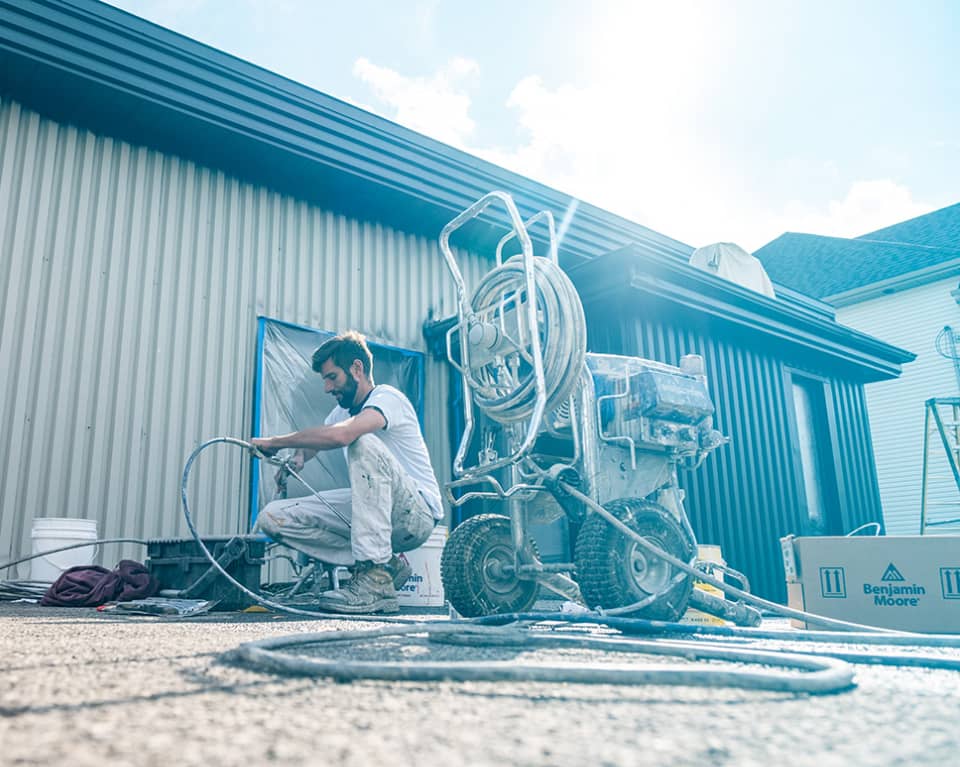We have all seen it, on one building or another: sometimes paint peels. The paint coat can form blisters, cracks, or it could detach easily when you pass your finger. But how to avoid such an unfortunate consequence? Well, we first need to understand the possible causes.
Inadequate Surface Preparation
Surface preparation procedures are often essential to get the necessary adhesion for the paint to stick well on the long term. Pressure washing to remove dirt and mold, scraping and sanding for corrosion, and replacing damaged parts are only a few of the recommended steps to be done before paint application. Applying a sealant or primer could also be necessary in some cases.
Surface Is Too Hot
We see this problem very frequently, even more so with exterior painting done in the middle of summer. You must always follow the manufacturer’s recommendations indicated on the label of your paint gallon. For the vast majority of paints being sold in Quebec, the application can be done safely, in the absence of rain or high relative humidity, between 10 ⁰C and 20 ⁰C. We must be even more careful with metal surfaces because they warm up faster and keep their heat longer. For those who would want to try painting a metal roof during a heat wave, please abstain from doing it: this would end up in blistering and peeling.
Surface Is Too Cold
Some products allow the application at a low temperature of 2 ⁰C. Once again, it’s crucial to read very carefully the product’s label. Don’t forget to make sure the surface temperature won’t go below the recommended temperature during all drying time and know the drying will take longer if it’s cold. In you’re not sure, don’t do it!

Product Incompatible With Substrate
Obviously, different types of products are conceived for different substrates, because a metal paint won’t have the same chemical composition than a paint made for wood. It is crucial to correctly identify your surface: is it made of wood, brick, concrete, iron, aluminum, vinyl or stucco? If it has already been painted, can you identify the type that was used? It’s important to go get good advice in a specialized paint store.
Product Non-Resistant To Bad Weather
For exterior painting, choose a paint destined to exterior use: it’s more likely to resist bad weather and great temperature variations like those we have here in Quebec.
Lack Of Uniformity In The Coat Thickness
If the thickness of the paint coat is not uniform, then the wind, rain, and other bad weather will pierce through faster where it is thinner. If you paint a surface on which you walk, more friction will happen on the bumps and that will lead to hurting the coat’s lifetime and the smooth appearance. Using a sprayer is often more efficient than the roller to apply a uniform coat on an exterior siding.
Inappropriate Mix Or Excessive Dilution
You are lacking paint to finish your project and you take a similar product to complete? Be careful! Even if they are the same category of paint, mixing two products that have not been created to be mixed together could lead to disastrous results. In most cases, there will only be a very slight demarcation, but your products might not have the same adhesion.
Excessive dilution of a paint has an impact on its chemical properties. Often, the paint will become clearer but could also adhere less. Dilution should only be done by professional painters.
You have a peeling paint problem? FinDecor is here.
FinDecor’s team of painters is so confident in the quality of their services that they now offer extended warranties on several of their paint jobs. Call us now for a free estimate.
Dave Beaupre
Master painter
514-966-0966



